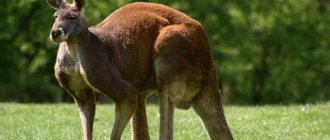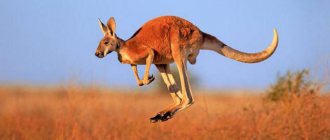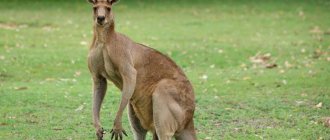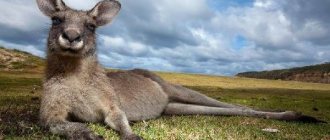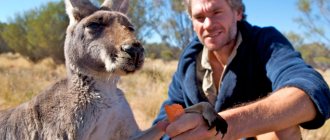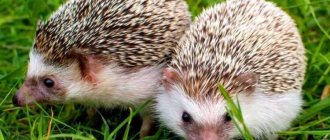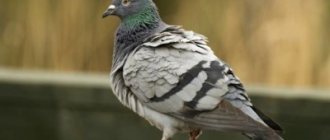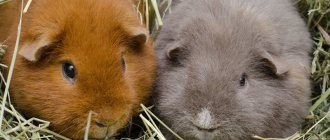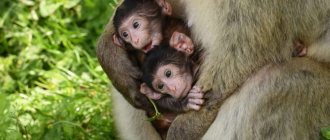How diverse the world is, how many amazing plants and animals live on our planet! And the kangaroo can safely be considered such a bright representative of nature, another of its miracles. Surely everyone knows in which country the kangaroo lives. Of course, in Australia. But many may have a question about where kangaroos live, besides Australia. They also live in New Zealand, New Guinea, the Bismarck Archipelago and Tasmania. In total there are more than fifty species of these animals. They all vary in size and weight. There are giant kangaroos: red and gray, there are kangaroo rats, wallabies - medium-sized individuals, and others.
Description and characteristics of the animal
The kangaroo is the only large mammal that moves by jumping. Animals are able to jump almost 3 m in height, while the length of the jump can reach 10 m. They are helped to push off the ground by well-developed hind legs and a long and powerful tail consisting of 20 vertebrae. In a kangaroo, the tail acts as an additional fifth limb. It is used as a support and also increases the force of upward and forward movement.
The maximum speed of kangaroos is from 40 km/h for small species to 60 km/h for large ones.
What sounds does a kangaroo make?
What does it look like
Short-clawed
The appearance of the kangaroo is quite unusual:
- the body is disproportionate with a narrow shoulder girdle and a very large lower part;
- the forelimbs are short, have five movable fingers with small but sharp claws, the hind legs are powerful, long, with well-developed muscles;
- the head is small, the muzzle is elongated, the ears are quite large;
- the fur is thick, soft, and may have a reddish, gray or black tint.
How much does it weigh
Big red
The kangaroo family includes species that vary significantly in weight and size. Below is a comparison table of the average weight and height of males of some varieties:
| Species of kangaroo | Weight | Length |
| Big red | 80 kg | 2 m |
| Antelope | 40 kg | 1.2 m |
| Western gray | 50 kg | 1.1 m |
| Swamp wallaby | 20 kg | 0.8 m |
| Short-tailed | 5 kg | 0.4 m |
Swamp wallaby
Sexual dimorphism
In kangaroos, the difference between individuals of different sexes is manifested in size. In some species, females are almost twice as small as males. Sometimes males have a brighter coat color, but it is quite difficult to determine the sex based on this feature.
NOBLE DEER
Mating process
Kangaroos do not have a specific season when mating should take place. But reproductive processes in representatives of all species of kangaroos occur very actively.
During the mating season, real fights between males can unfold for the attention of a female. A very important role in these fights is played by the tail, which actually serves as the fifth leg. The winner gets the right to mate. Despite a developed sense of competition for a female, males have completely absent parental instincts. After the love games are over, the male disappears. The female must take care of whether the offspring will survive.
Species of kangaroo
Bennett
The kangaroo family is very numerous. The most interesting varieties include the following:
- Bennett's kangaroo . The largest arboreal mammal in Australia. The weight of sexually mature males can reach 12-14 kg. Tree kangaroos are very agile: they not only quickly climb trees, but can also jump over branches located at a distance of up to 8-9 m from each other. Animals are able to jump to the ground from a height of 18 meters.
- Mountain kangaroo (or mountain wallaroo ). It differs from other species in its physique: the shoulders are somewhat wider, and the length of the hind limbs is shorter, which is why the animal appears squat. Mountain kangaroos are much darker than their relatives. The upper part of the body is gray, almost black, and the paws and tail are dark brown. This color scheme allows the animals not to be too noticeable against the background of rocky ground.
- Goodfellow's tree kangaroo . Endemic to the island of New Guinea. This is perhaps the only kangaroo that does not hop. The inability to jump is explained by the presence of short hind limbs in the species. The animal has an interesting color: the head and back are red-brown, the belly is beige, and there are two light stripes along the back from the neck to the tail. Goodfellow's kangaroos are listed as endangered on the International Red List.
- Short-clawed or dwarf kangaroo . The species is distinguished by early sexual maturation, which occurs at 5-7 months in females and 9-14 months in males. In a year, a female dwarf kangaroo manages to give birth to three cubs. Despite this relatively high fertility, the population size is constantly declining. The species is listed as vulnerable on the IUCN Red List.
- Rufous-gray wallaby . The species belongs to the genus of gigantic kangaroos and is of medium size: length reaches 1 m, and weight - 20 kg. The standard color of individuals is considered to be a red-gray back and a gray-brown chest and paws, but among representatives of this species there are frequent cases of the birth of cubs with light, almost white fur. Bruny Island, located in the Tasman Sea, is known to be home to a small population of albino wallabies.
- Quokka . One of the smallest kangaroos, which in appearance resembles a rodent. The quokka's tail is short, thin and cannot serve as a support for the animal.
quokka
In biological taxonomy, more than 20 species of kangaroos have been identified, which are classified as extinct. Some of them ceased to exist several thousand years ago, and their descriptions have been reconstructed from the remains found as a result of excavations. Some species have been lost at present: the long-eared kangaroo was exterminated at the end of the 19th century, the moon-clawed kangaroo and Gray's kangaroo disappeared at the beginning of the last century.
Moonclaw
Gray Kangaroo
Wallaby
Wallabies are marsupials belonging to the Kangaroo family. It is an exact copy of a gigantic kangaroo, only in a smaller form. These animals reach seventy centimeters in height and weigh up to twenty kilograms. There are up to fifteen species of this animal, some are on the verge of extinction, such as the striped wallaby. Almost nothing remains of the once abundant species. They are found only on two islands located off the west coast of Australia. There are mountain wallabies, and there are swamp wallabies. They do not differ in appearance and habits - only in their habitat.
Where does it live?
The ancestors of modern kangaroos and other marsupials in the Mesozoic era were distributed on almost all continents. Subsequently, they were replaced by other subclasses of mammals and survived only in Australia due to its geographic isolation. The results of excavations and research indicate that the historical homeland of the kangaroo is South America.
Currently, the habitat also extends to the islands of Tasmania and New Guinea. There are also kangaroos in the Bismarck Archipelago. After its introduction, the animal successfully adapted to New Zealand.
Where live
The kangaroo's natural habitat is plains with tall grass, thickets of bushes and sparse trees, which provide shelter on hot days.
Ringtail
There are about 15 species in the kangaroo family that have adapted to life in rocky regions. Rock wallabies (or rock kangaroos) are distinguished by their relatively medium size and dark shades of fur. During the daytime, they hide in caves and crevices, and in the evening they descend into the valleys in search of food.
Goodfellow's tree kangaroo
Another family unites species that have adapted to live in trees. The genus of tree kangaroos has 10 species inhabiting the tropical forests of Australia and nearby islands.
PLATYPUS
History of the name of the animal
The animal received such an eccentric name - “kangaroo” - thanks to the discoverers of a continent unknown at that time. When the Europeans saw these amazing animals, they asked the aborigines: “Who is this?” To which the locals responded, “Ken Gu Ru,” which translates to “we don’t understand.” The sailors thought that this was the name of the animal. That’s how the name “kangaroo” stuck to him.
What do kangaroos eat?
Animals go out in search of food at dusk. Kangaroos feed once a day. The diet includes plant food; in rare cases, marsupials can feast on bird eggs.
The menu can be very varied and includes juicy bulbs and tubers, leaves, berries, seeds, herbs, and mushrooms. Kangaroos are able to eat plants that other animal species do not eat.
Herds living in arid regions can go without water for a long time, receiving a small amount of it from feed. In case of prolonged drought, animals dig wells.
Nutrition
Kangaroos eat only once a day. This happens just after sunset. It is safer for them to act this way. This is especially advisable, since by this time in tropical regions the heat is waning.
In terms of nutrition , the kangaroo is animal and prefers a menu of plant-based delicacies. Larger species feed on tough, thorny grass. Those of them that naturally have a short muzzle usually prefer to include bulbs, tubers and roots of a wide variety of flora in their diet. Some kangaroos love mushrooms. Small species of wallabies feed on fruits, seeds and grass leaves.
Kangaroo eats leaves
Such food does not differ in calorie content. However, kangaroos try to compensate for this deficiency with a variety of grasses and plants. True, predatory habits are inherent in tree kangaroos. In addition to bark, they can eat chicks and bird eggs.
These representatives of the animal world of the Green Continent drink surprisingly little, receiving enough moisture for their bodies from dew and plant juices. However, during dry periods the urgent need for water still begins to take its toll. In such unfavorable times, large kangaroos save themselves by digging wells. They can be quite deep; it happens that they go underground to a depth of 100 meters or more.
Lifestyle
Most kangaroo species are nocturnal. The animals go out to graze at dusk, and when they are full, they return to the center of their territory and rest in the shade of the trees. Females tend to graze longer and choose foods that contain more nutrients.
Kangaroos are considered herd animals. They form groups, the number of which can reach 100 individuals. However, unlike other social mammals, animals living in the same herd do not unite for protection from enemies and do not jointly protect their habitat.
Each herd consists of several groups: females with cubs, young sexually mature males, adults past reproductive age.
Care of offspring
The functions of the female do not end with giving life to the offspring and feeding them. She ensures their safety and also keeps the bag clean. Since small kangaroos do not leave their habitat for the first months of life, all the products of their vital activity also remain in it. Therefore, the female opens it and simply licks the cubs until they grow up.
She also puts the bag away after the baby kangaroos leave her for good. This often happens when the young offspring no longer fit there. It happens that the mother kicks them out on her own.
This is interesting: What do raccoons eat in the wild?
How do they reproduce?
The reproduction of kangaroos in the wild is not strictly tied to the seasons. Females give birth every year until they are 10-12 years old. The timing of puberty in females depends on the species: in larger animals, maturation occurs at the age of 2 years, in small kangaroos - at 9-10 months. Males mature somewhat later, but do not immediately participate in reproduction, since older and stronger competitors do not allow them to approach females.
Kangaroo pregnancy lasts just over a month. Usually one cub is born. Only females of the large red kangaroo can give birth to two or even three babies. The born kangaroo weighs about 700 mg and looks like a fetus: its eyes are bulging and underdeveloped, its ears are not formed, its hind legs and tail resemble small stumps. However, the baby has fully formed front paws with claws, as well as nostrils and a smell center in the brain. Researchers believe that it is thanks to this that a newly born kangaroo is able to independently crawl into its mother’s pouch and attach itself to the nipple there.
At first, the baby cannot suck milk on his own, so the female periodically contracts the muscles on the gland and injects him with nutritious fluid. The edge of the pouch has muscle fibers, thanks to which the leathery pocket is securely closed and protects the cub from cold and moisture. Depending on the species, a baby kangaroo's stay in the pouch can last from 4 to 8 months. The female herself decides when to let him out.
The next mating of kangaroos occurs immediately after birth. The development of the resulting embryo begins only after the previous baby leaves the pouch. For some time, the grown cub follows the mother and continues to periodically suck milk.
Social structure and reproduction
Photo: Baby giant kangaroo
There is no specific time of year when mating season occurs. They can reproduce all year round. Males fight for the right to court a female. This is reminiscent of human fights without rules. The animals stand on their hind limbs, leaning on their tail, and begin to hit each other with their forelimbs. In such fights, serious injuries can be caused to each other. Males tend to mark their territory with saliva, which has a specific odor. He can leave such marks on grass, bushes, trees, and on females that attract their attention. Thus, they give information to other males that this female is already occupied.
Females reach sexual maturity at approximately 2-2.5 years. In males, this period begins somewhat later. With age, males increase in size, which increases their chances of winning the fight for the right to enter into mating relations. In some groups, the largest male may do most of the mating.
Pregnancy lasts only a month. It is noteworthy that animals lack a placenta and have as many as three vaginas. One of them is intended for bearing and giving birth to a baby, the other two are for mating. Most often, one female gives birth to one calf. Due to the absence of a placenta, kangaroo babies are born very weak, underdeveloped and helpless. After birth, the female transfers them to her fur pouch. There they attach themselves to the nipple and spend almost another year until they get stronger and grow. In underdeveloped babies, the sucking reflex is not developed, so the female herself regulates the flow of milk to the baby by contracting certain muscle groups. The babies are kept in the mother's pouch until she gives birth to new offspring.
Interesting facts about kangaroos
- Having noticed the danger, kangaroos begin to knock on the ground with their paws and tail, thus giving an alarm signal.
- Female kangaroos are capable of simultaneously producing several types of milk with different fat contents. If a female simultaneously feeds two cubs of different ages, each of them will suck the milk intended for it from its own nipple.
- The number of kangaroos in Australia is almost three times higher than the number of people inhabiting the continent.
- When moving, the kangaroo jumps, making synchronous movements with both paws. On land, the animal is not able to move its hind limbs alternately, but a kangaroo swimming in water can have its paws move differently.
- Despite their apparent harmlessness, marsupials can pose a serious danger to people: the force of a kangaroo's blow is such that it can easily break bones or even kill an adult.
Features of character and lifestyle
Photo: Giant kangaroo
Giant kangaroos are animals that live in groups. These are small groups of animals, consisting of one or more males and several females, as well as cubs. The leading position is assigned to the male. Grown-up cubs leave their family to build their own. The group exists in a strict hierarchy. Leaders are given the best place during sleep and rest, as well as the most delicious and juicy food.
It is noteworthy that it is unusual for groups of kangaroos to occupy certain territories, so there is no hostility for habitat among them. If the habitat contains the necessary amount of food, as well as favorable climatic conditions, and is not inhabited by predators, kangaroos can form numerous groups, consisting of up to 7-8 dozen individuals. They can simply, for no apparent reason, leave the area where they have settled and go to another place.
They are most active at night and in the dark. This reduces the risk of being hunted by predatory animals. During the day they prefer to rest or sleep in a shady area, sheltered from the intense heat. For permanent habitat, animals dig holes for themselves with their front paws, or build nests from grass and other types of vegetation. As soon as any member of the group senses the approach of danger, he begins to pound his front paws on the ground and make certain sounds resembling clicking, grunting, or hissing. The rest of the group takes this as a signal to flee.
Interesting! Kangaroos use their hind limbs as a means of self-defense and defense, which have enormous impact force.
What do kangaroos eat in the wild?
Kangaroos are herbivores. Like cows, they chew grass, swallow and regurgitate it to make it digestible. Eating can occur at different times of the day and depends on the ambient temperature. During hot periods, kangaroos can lie in the shade all day and go out to eat at night. One of the most amazing features is that kangaroos can go for months without water. On dry days, they feed on grass and tree bark, thus saturating their body with moisture.
"Foster Mom"
As is known, offspring from different mothers differ in smell, thanks to which the female recognizes her children. It is generally accepted that kangaroos do not have a tendency to adopt. Nature provides that there are two cubs in the bag, so there is no room for others. However, cases have been recorded when someone else's offspring, with the permission of the female, ate and slept in her pouch. Most often this happens when the older cub dies. Thus, the second nipple remains free, but milk continues to be produced.
Scientists have also recorded cases where females exchanged their babies. The reason for their behavior remains unknown.
Scientists have no evidence that kangaroos “adopt” the cubs of other animals.
"The large family
1-2 months after the birth of the first baby, the female is again ready for mating. When the second calf is born, the first one still continues to live in the pouch. Thus, at the same time, a female kangaroo cares for two children of different ages. The fabrics of the bag are very elastic, and they are able to support the weight of the offspring once they begin to grow.
At the time when the second baby appears, his older brother begins to feed on milk from the second nipple, which, as already mentioned, differs in its composition.
In some species of kangaroo, for example quokka, nature provides for the conception of two embryos at once. But first, one baby develops, and only when it reaches one month does the development of the second begin. If the first fruit dies, the growth of the second begins immediately. Thus, the species we are considering does not need to waste time on additional mating.
The birth of twins or triplets also occurs in other, larger species of kangaroos. Photos taken by scientists prove the existence of such “large” families.
Typically, the baby spends about seven months in its mother's pouch. Having become old enough, he begins to get out of it for a while and try plant foods. However, at the first sign of danger, he again seeks shelter in his mother’s bag. Only after the cub finally gets stronger does it begin an independent life.
Insects
On the Australian continent, relatively large insects are quite common and pose a certain danger to humans.
meat ant
This type of insect represents small ants that are characterized by very aggressive behavior. Each ant family can have more than 50 thousand individuals. Such families form entire colonies, which can be more than half a kilometer in length.
Sailboat Ullys
This diurnal butterfly has a wingspan of up to 15 centimeters. The main color of the wings is black, with extensive spots of blue or blue on the wings. The tips of the wings have a black border. The lower wings end in tails with a slight expansion.
Cactus moth
This is a small Australian butterfly of a brownish-gray color, with noticeable antennae and legs. The front wings have some differences in the nature of the pattern, as well as due to the presence of small stripes. The hind wings are characterized by a lighter color. The wingspan is within 4 cm.
Habitat
Kangaroos live, of course, throughout the entire continental part of Australia, and inhabit almost all corners of the country. But in the wild, these marsupials are found not only on the mainland; they also live on nearby archipelagos and islands.
Kangaroos can be found in any region of the Green Continent
Kangaroos are common in the following natural areas:
- Island of New Guinea (including the territory of the independent state of Papua New Guinea);
- Bismarck Archipelago;
- Tasmania Island;
- Cape York Peninsula;
Kangaroos also inhabit the Polynesian island of New Zealand, washed by the waters of the Pacific Ocean. Moreover, these marsupials are not the indigenous inhabitants of the island, but were brought there at the whim of European colonists at the end of the 19th century. Oddly enough, the kangaroos liked their new home; they successfully adapted to the subtropical climate of New Zealand, and even settled in cold mountainous regions.
